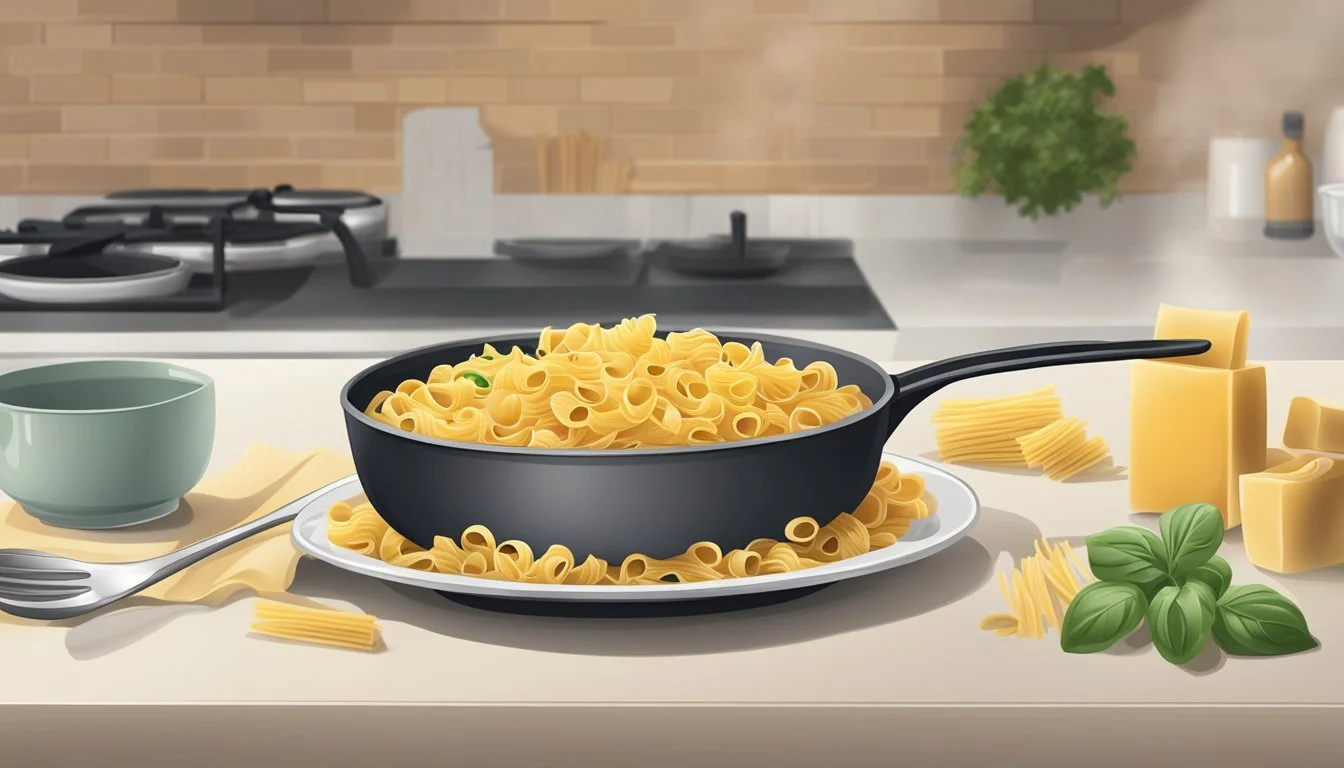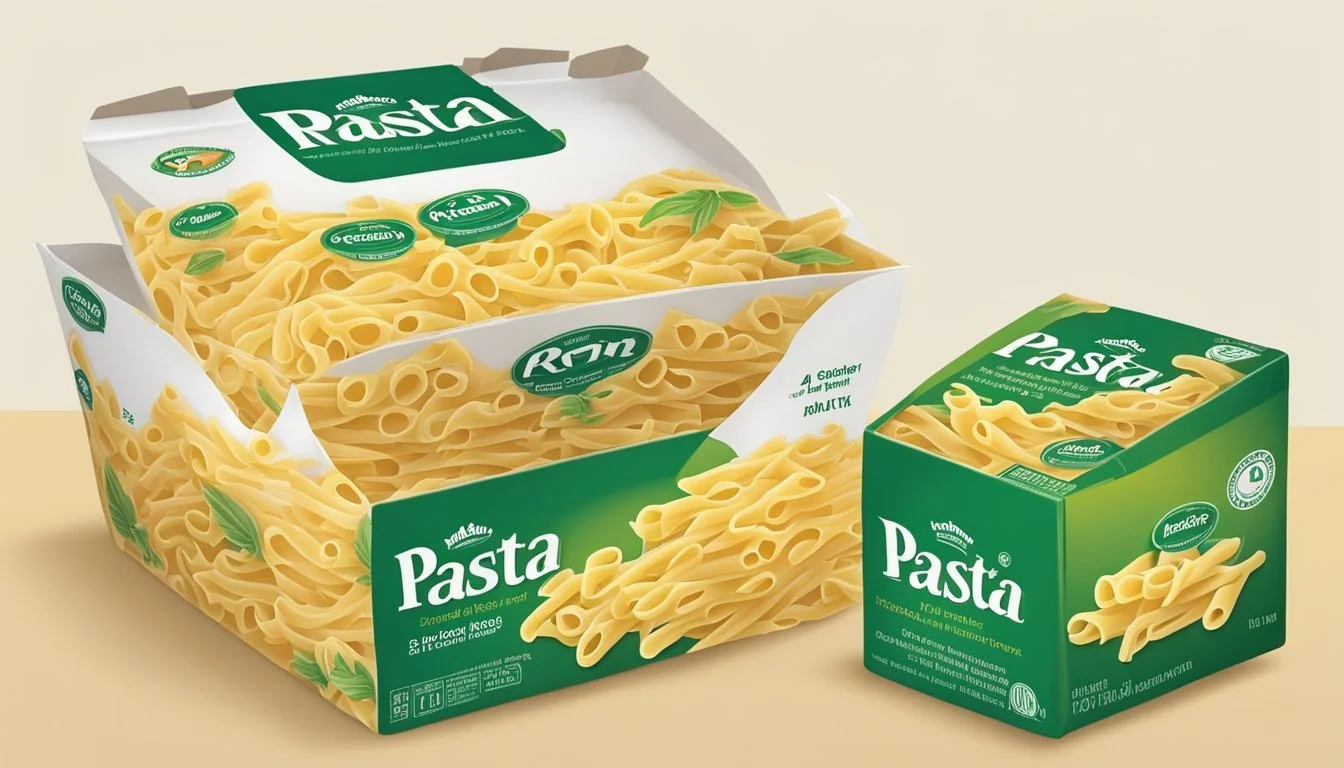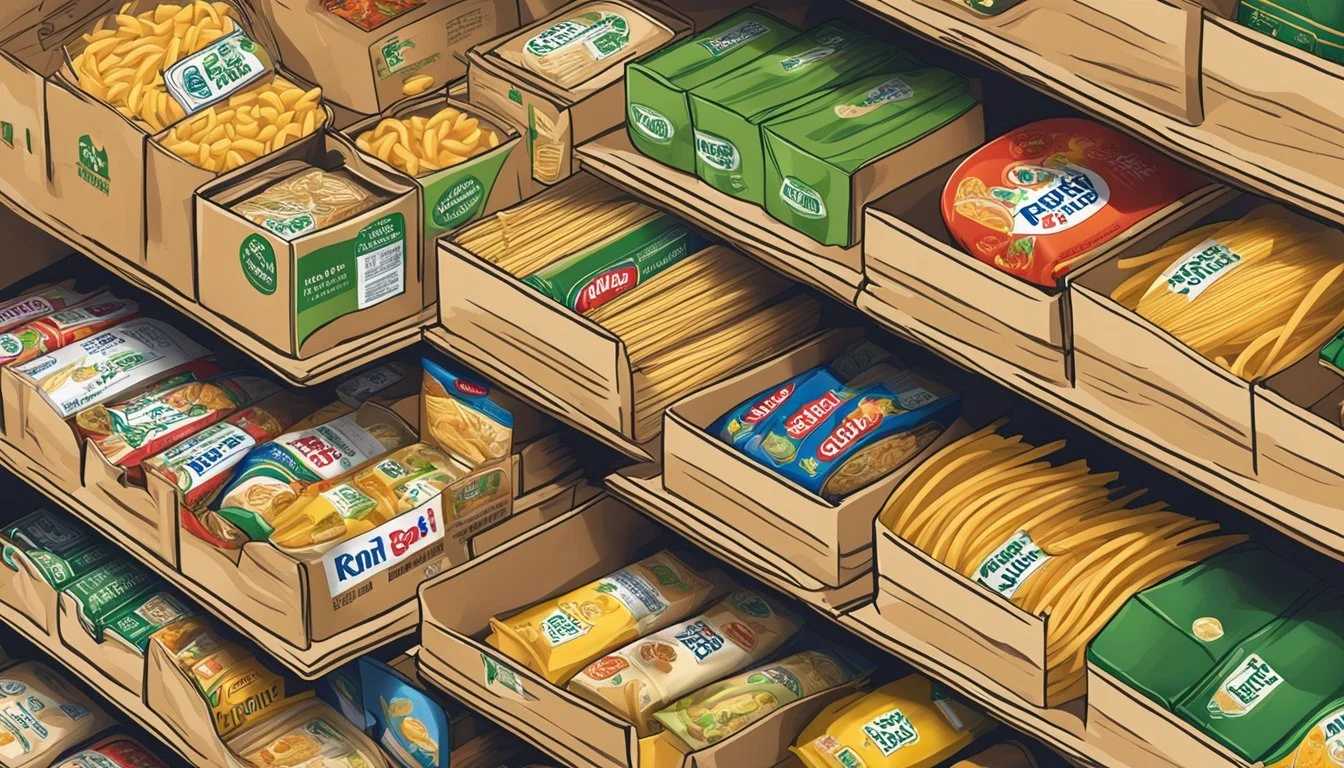How Long Does Pasta Roni Last?
Shelf Life and Storage Tips
Pasta (What wine goes well with pasta?) Roni, a popular convenience food, offers a quick and savory solution for meals, but understanding its shelf life is crucial for both safety and quality. A box of Pasta (how long does pasta last?) Roni comes with a "Best if Used By/Before" date, suggesting a time frame where the product is expected to retain its peak flavor and quality. Typically, this date ranges from one to two years from the time of packaging.
Once prepared, the shelf life of Pasta Roni changes. It is advisable to consume homemade Pasta Roni within four days when stored properly in the refrigerator. This ensures that the taste and texture remain as intended. While dry, uncooked pasta can last well beyond its expiration date when kept in a cool, dry place, a package that is past its expiration date should be examined for signs of spoilage such as changes in texture or smell. If these signs are present, the product should be discarded to avoid potential foodborne illnesses.
Understanding Pasta Roni
Pasta Roni is a convenient side dish that combines pasta with flavorful seasonings, often requiring only simple preparation steps. This section will discuss the variety of Pasta Roni available and the primary components that define this quick meal solution.
Types of Pasta Roni
Pasta Roni offers an assortment of pasta types and flavors to suit different tastes and preferences. Here are some common varieties characterized by their pasta shapes and flavor profiles:
Angel Hair Pasta (how long does angel hair pasta last?) with Herbs: Thin, delicate strands of pasta with a mix of aromatic herbs.
Rotini with Alfredo Sauce: Corkscrew-shaped pasta enveloped in a creamy cheese sauce.
Rice-a-Roni: Although not a pasta, this rice (how long does rice last?)-based product is included in the brand and comes in flavors like Chicken and Beef.
Each type provides a unique texture and base for the rich flavors that Pasta Roni is known for.
Trust me, the easiest way to buy Pasta Roni is through online retailers!
Key Ingredients
The core ingredients found in a typical box of Pasta Roni include:
Pasta: Made mainly from semolina wheat, providing the essential canvas for the dish.
Seasoning Mix: Varies by flavor, commonly including cheese, herbs, and spices.
Additives: Ingredients such as oil, butter, or milk are often required to be added by the consumer to achieve the desired creamy texture.
An ingredient breakdown for a hypothetical Cheese flavor might look like this:
Ingredient Purpose Semolina To form the pasta base. Cheese For a rich flavor and creamy texture. Milk Often added to enhance creaminess. Butter Added for flavor and to combine ingredients.
Understanding the essential elements of Pasta Roni's composition allows consumers to make informed choices about preparing and consuming this dish.
Storage Guidelines
Proper storage ensures maximum shelf life for Pasta Roni products, whether unopened, opened, or homemade. Adhering to ideal storage conditions can enhance the longevity and quality of the pasta.
Unopened Boxed Pasta Roni
Unopened boxes of Pasta Roni should be kept in a cool, dry place such as a pantry. The shelf life of unopened dried Pasta Roni typically extends well beyond the "best by" date when stored correctly, generally lasting up to 1-2 years. Moisture and heat can compromise the quality, so they should be avoided.
Opened Boxed Pasta Roni
Once opened, the remaining Pasta Roni should be transferred to an airtight container to protect it from moisture and other contaminants. The contents should be used within 1-2 weeks when stored at room temperature. For prolonged freshness, one may consider refrigerating the opened pasta, tightly sealed, where it can last for 2-3 weeks.
Skip the lines and order your airtight container online for a stress-free shopping experience!
Homemade Pasta Roni
Homemade Pasta Roni, typically incorporating fresh ingredients, has a significantly shorter shelf life. For best results, it should be stored in the refrigerator in an airtight container, where it can keep for up to 3-5 days. If one wishes to store it for longer, freezing is an option; homemade Pasta Roni can last in the freezer for up to 1-2 months. However, the texture and taste may change slightly upon thawing.
Expiration and Shelf Life
When considering the shelf life of Pasta Roni, one should understand that expiration dates are indicators of quality, not safety. By assessing the shelf life, you can ensure both palatability and safety of the product.
Identifying Shelf Life
The shelf life of Pasta Roni typically ranges from one to two years when referring to the best before date on the packaging. This date provides a guideline on when the product is likely to be at its freshest and most flavorful. It is not, however, an absolute indicator of safety as the product might still be safe to consume beyond this period if stored correctly.
Best Before Date: A manufacturer's estimate of product quality maintenance.
Extending Shelf Life
To prolong the shelf life of Pasta Roni, it should be stored in a cool, dry place, protected from temperature fluctuations and moisture which can negatively affect the quality. Keep the packaging intact until use, as once opened, the pasta's shelf life may be compromised.
Storage Tips:
Keep in a cool, dry, stable environment.
Maintain intact packaging until use.
Safety Considerations
Safety is paramount when consuming any food product past its best before date. Signs such as changes in smell, mold growth, or discoloration indicate spoilage, making the pasta unsafe to eat and should be discarded immediately to prevent the risk of foodborne illness.
Spoilage Indicators:
Pungent or off-putting odor.
Visible mold or unusual changes in color.
Shelf Life of Different Pasta Roni Varieties
Different varieties of Pasta Roni may have slightly varying shelf lives due to ingredients and packaging. Plain pasta typically lasts longer than varieties with cheese or other added components. Always refer to the specific packaging for the most accurate expiry information for each variety.
Variety Considerations:
Plain pasta varieties tend to have a longer shelf life.
Added ingredients such as cheese can shorten shelf life.
Preparation and Cooking Tips
To achieve the best quality and flavor from Pasta Roni, it's important to follow cooking instructions carefully and consider some creative variations for added taste.
Cooking Pasta Roni
To cook Pasta Roni, one should start by bringing a large pot of lightly salted water to a rolling boil. Adding the pasta and cooking it for the timeframe suggested on the package, usually 8 to 10 minutes, will ensure that the pasta reaches al dente texture, which is firm to the bite but not hard. After cooking, it is crucial to drain the pasta thoroughly. Alternatively, for a quicker option, one can use a microwave. Combining the pasta, water, seasoning mix, and butter in a microwave-safe dish and cooking on high for approximately 15 minutes, stirring halfway through, produces a satisfactory result.
Stovetop Method:
Boil water with a pinch of salt
Cook pasta for 8-10 minutes
Drain and serve
Microwave Method:
Combine ingredients in a microwave-safe dish
Cook on high for 15 minutes
Stir and rest before serving
Recipe Variations
Experimenting with seasonings such as crushed red pepper (how long does crushed red pepper last?) flakes or garlic powder can distinctly enhance the taste of Pasta Roni. One can begin with a 1/4 teaspoon of red pepper flakes (how long do red pepper flakes last?) for a touch of heat or 1/2 to 1 teaspoon of garlic powder for a deeper savory flavor. Adding dried herbs (how long do dried herbs last?) like parsley can contribute an earthy note. A suggestion is to use 1-2 teaspoons depending on personal taste preferences.
Sauté Option:
Sauté additional ingredients before adding pasta
Use flavors like garlic or vegetables for more complexity
Enhanced Flavorings:
Crushed red pepper flakes (1/4 teaspoon)
Garlic powder (1/2 to 1 teaspoon)
Dried parsley (how long does dried parsley last?) (1-2 teaspoons)
By adhering to the cooking instructions and exploring various recipe variations, one can ensure that Pasta Roni is not only cooked to perfection but also tailored to individual taste profiles.
Serving Suggestions
When it comes to serving Pasta Roni, it's not just about the pasta itself but what accompanies it. The dish can be customized to suit a variety of tastes and can serve as a side or be augmented into a main course.
Dish Pairing Ideas
Pasta Roni pairs excellently with vegetables, making it a versatile side to round out a meal. Here are some specific combinations:
Grilled Chicken: A lean and flavorful protein like grilled chicken complements the pasta's rich taste.
Roasted Vegetables: Charred veggies like bell peppers, zucchinis, and onions add a smoky flavor and nutritional boost.
Seared Shrimp: Adding succulent seared shrimp can transform Pasta Roni into an elegant main course.
Creative Add-Ins
To elevate the dish further and introduce a variety of textures and flavors, consider the following add-ins:
Sausage: Incorporating cooked slices of sausage infuses a savory depth to the pasta.
Beans: For a hearty touch, one can stir in kidney or cannellini beans (how long do cannellini beans last?), which add protein and fiber.
Spices: A hint of spice such as paprika or chili flakes can lend a warm kick.
Fresh Herbs: (how long do fresh herbs last?) A sprinkle of chopped parsley or other fresh herbs can brighten the dish and add a pop of color.
Signs of Spoilage and How to Identify
When assessing whether Pasta Roni—a popular brand of flavored pasta and rice packets—has gone bad, one should look for a few telltale signs. Here's a quick guide to determine if your Pasta Roni has spoiled:
Visual Check:
Mold: Look for any visible mold growth, which may appear as fuzzy spots of green, white, or black.
Discoloration: Pasta that exhibits significant changes in color may indicate spoilage.
Smell Test:
Off Odor: If the pasta smells musty, sour, or otherwise unpleasant, it's a strong indicator that it should be discarded.
Texture Examination:
Unusual Texture: If the dried pasta feels sticky, slimy, or abnormally soft, these are signs of potential spoilage.
Quality Assessment: Pasta Roni typically has a shelf life of about 1-2 years when unopened and stored properly. However, much like other dried pasta, it remains safe to eat beyond this timeframe if there are no signs of spoilage.
For those who value food safety and quality, it's essential to observe the product carefully before preparation. Should any doubt arise regarding the condition of the Pasta Roni, it's advisable to err on the side of caution and avoid consumption.
Nutritional Information
Pasta Roni is a pre-packaged pasta dish that comes with a variety of flavors and seasonings. A typical serving contains an assortment of nutritional elements.
For a clearer understanding, here's a breakdown of the nutritional components usually found in a serving of Pasta Roni:
Calories: A single serving of Pasta Roni generally ranges between 200 to 250 calories before any additions like butter or milk.
Protein: It offers a modest amount of protein, approximately 6 to 7 grams, which can contribute to one's daily intake.
Fiber: Depending on the variety, fiber content may be low, often less than 1 gram per serving.
The presence of sauce options, which often include creamy textures or cheese-based varieties, can impact the fat and calorie content significantly. Cheese-flavored options tend to be higher in calories and saturated fats due to the cheese and cream ingredients used to create rich and comforting flavors.
Most Pasta Roni products come with a seasoning mix. This mix typically contains herbs and spices that enhance the taste but do not contribute much to the nutritional value in terms of calories, though they may add minimal amounts of sodium.
Below is a tabulated nutrition summary for a standard serving of Plain Pasta Roni:
Nutrient Amount Calories 220 Protein 7g Fiber <1g Fat 3.5g
Keep in mind that preparation methods and added ingredients like milk or butter will alter these figures. Always check the package for the most accurate, product-specific nutritional information.
Frequently Asked Questions
This section addresses common inquiries regarding the shelf life, preparation, and dietary considerations of Pasta Roni, providing precise and practical information for consumers.
Reheating and Leftovers
When reheating Pasta Roni leftovers, it is essential to ensure they reach a temperature of at least 165°F to maintain food safety. Leftovers should be stored in the refrigerator and consumed within 3-5 days. They can be reheated in a microwave or on the stovetop, possibly with a touch of water or margarine to restore moisture.
Allergy and Dietary Concerns
Pasta Roni products may contain allergens such as wheat or dairy, so consumers should inspect the packaging for specific ingredients. For those with dietary restrictions, there are varieties available that accommodate different needs. For example, choices with rice, angel hair pasta, penne, or macaroni offer diversity, and some options may include parmesan cheese or can be prepared without margarine for a lighter version.
Purchasing and Brand Varieties
When purchasing Pasta Roni, it's advisable to observe the 'best by' date to ensure quality. The brand offers a range of pasta types, from traditional angel hair to penne and macaroni, which are often highlighted on social media platforms like Instagram. Consumers may encounter different flavors and formulations, and while boxed products like Rice-A-Roni have a shelf life of approximately 1-2 years, it's recommended to inspect the box and use products before the 'best by' date.
Homemade Pasta Roni Recipes
Homemade Pasta Roni is a versatile dish that can be tailored to a variety of tastes, from the traditional herbed angel hair to inventive flavors like spinach tortellini. The recipes below outline how to create these comfort dishes at home.
Basic Garlic Noodles:
Sauté minced garlic in olive oil.
Add cooked angel hair pasta to the sauté pan.
Mix in a blend of salted butter and fresh parsley for a simple, aromatic dish.
Creamy Variations:
For a richer flavor:
Stir in heavy cream or substitute with skim milk for a lighter option.
Combine with freshly grated Parmesan cheese until melted and smooth.
Mac and Cheese Style:
Prepare your pasta of choice according to the recipe.
Integrate a homemade cheese sauce made from a roux base and a mixture of cheeses for that classic mac and cheese comfort.
Spaghetti Bolognese Twist:
Begin with a hearty bolognese sauce simmering on the stove.
Cook spaghetti until al dente and fold into the rich, meaty tomato sauce.
Spinach Tortellini Option:
Opt for cheese-filled spinach tortellini instead of regular pasta for an extra layer of flavor.
Sauté with garlic, fresh spinach, and a touch of cream to complete the dish.
Recipes can be fine-tuned according to personal preference, ensuring each homemade Pasta Roni dish is both comforting and satisfying. Remember that variations in preparation can result in a dish that's uniquely yours.










